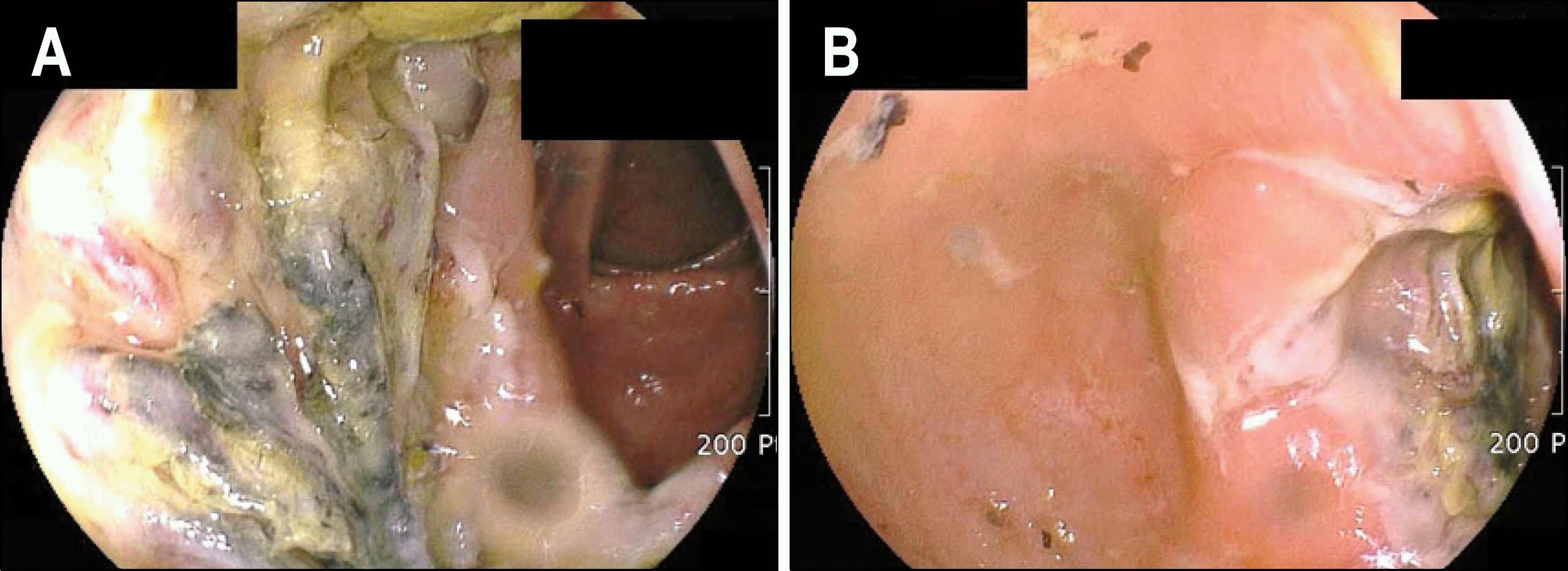Abstract
A 63-year-old woman was admitted due to right upper quadrant abdominal pain. She was going through hemodialysis due to end stage renal disease and taking calcium polystyrene sulfonate orally and rectally due to hyperkalemia. Colonoscopy showed a circular ulcerative mass on the proximal ascending colon. Biopsy specimen from the mass showed inflammation and necrotic debris. It also revealed basophilic angulated crystals which were adherent to the ulcer bed and normal mucosa. These crystals were morphologically consistent with calcium polystyrene sulfonate. She was diagnosed with calcium polystyrene phosphate induced colonic necrosis and improved with conservative treatment.
REFERENCES
1. Brenner BM. Brenner & Rector's The Kidney. 8th ed.Phila-delphia: Saunders;2007.
3. Monzú B, Caramelo C, Traba ML, Garví a R. Effect of potas-sium-chelating resins on phosphorus absorption. Nephron. 1994; 68:148.

4. Rashid A, Hamilton SR. Necrosis of the gastrointestinal tract in uremic patients as a result of sodium polystyrene sulfonate (Kayexalate) in sorbitol: an underrecognized condition. Am J Surg Pathol. 1997; 21:60–69.
5. Kelsey PB, Chen S, Lauwers GY. Case records of the Massachusetts General Hospital. Weekly clinicopathological exercises. Case 37-2003. A 79-year-old man with coronary artery disease, peripheral vascular disease, end-stage renal disease, and abdominal pain and distention. N Engl J Med. 2003; 349:2147–2155.
6. Lillemoe KD, Romolo JL, Hamilton SR, Pennington LR, Burdick JF, Williams GM. Intestinal necrosis due to sodium polystyrene (Kayexalate) in sorbitol enemas: clinical and experimental support for the hypothesis. Surgery. 1987; 101:267–272.
7. Wootton FT, Rhodes DF, Lee WM, Fitts CT. Colonic necrosis with Kayexalate-sorbitol enemas after renal transplantation. Ann Intern Med. 1989; 111:947–949.

8. Gerstman BB, Kirkman R, Platt R. Intestinal necrosis associated with postoperative orally administered sodium polystyrene sulfonate in sorbitol. Am J Kidney Dis. 1992; 20:159–161.

9. Scott TR, Graham SM, Schweitzer EJ, Bartlett ST. Colonic necrosis following sodium polystyrene sulfonate (Kayexalate)- sorbitol enema in a renal transplant patient. Report of a case and review of the literature. Dis Colon Rectum. 1993; 36:607–609.
10. Bennett LN, Myers TF, Lambert GH. Cecal perforation associated with sodium polystyrene sulfonate-sorbitol enemas in a 650 gram infant with hyperkalemia. Am J Perinatol. 1996; 13:167–170.

11. Dardik A, Moesinger RC, Efron G, Barbul A, Harrison MG. Acute abdomen with colonic necrosis induced by Kayexalate- sorbitol. South Med J. 2000; 93:511–513.
12. Rogers FB, Li SC. Acute colonic necrosis associated with sodium polystyrene sulfonate (Kayexalate) enemas in a critically ill patient: case report and review of the literature. J Trauma. 2001; 51:395–397.

13. Shioya T, Yoshino M, Ogata M, et al. Successful treatment of a colonic ulcer penetrating the urinary bladder caused by the administration of calcium polystyrene sulfonate and sorbitol. J Nippon Med Sch. 2007; 74:359–363. foration following oral sodium polystyrene sulfonate (Resonium A/Kayexalate) in a burn patient. Burns. 2002; 28:189–190.

14. Minford EJ, Hand T, Jones MC. Constipation and colonic perforation complicating calcium resonium therapy. Postgrad Med J. 1992; 68:302.

15. Reilly PM, Bulkley GB. Vasoactive mediators and splanchnic perfusion. Crit Care Med. 1993; 21(suppl 2):S55–S68.





 PDF
PDF ePub
ePub Citation
Citation Print
Print




 XML Download
XML Download